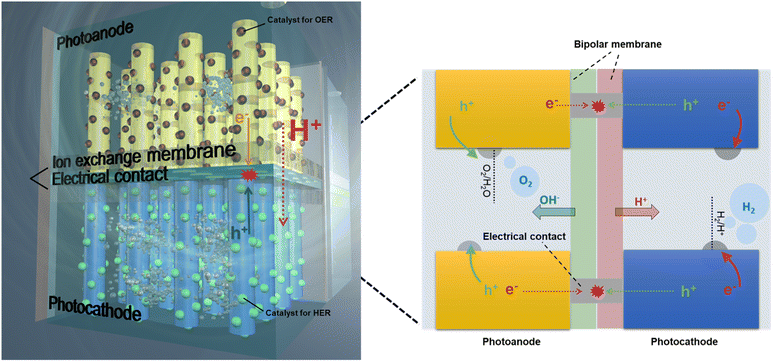Designing idealised devices for bias-free solar water splitting
Jaemin
Park
a,
Kwang Ho
Kim
 abc,
Dukjoon
Kim
abc,
Dukjoon
Kim
 a,
Jung Kyu
Kim
a,
Jung Kyu
Kim
 a and
Wooseok
Yang
a and
Wooseok
Yang
 *abcd
*abcd
aSchool of Chemical Engineering, Sungkyunkwan University (SKKU), Suwon 16419, Republic of Korea. E-mail: wooseok.yang@skku.edu
bKIST-SKKU Carbon-Neutral Research Center, Sungkyunkwan University (SKKU), Suwon 16419, Republic of Korea
cClean Energy Research Center, Korea Institute of Science and Technology, Seoul 02792, Republic of Korea
dSKKU Institute of Energy Science and Technology (SIEST), Sungkyunkwan University, Suwon 16419, Republic of Korea
First published on 26th December 2023
Abstract
The efficient conversion of solar energy into storable and distributable hydrogen is challenging, particularly in the development of cost-effective and efficient devices. As efficiency and cost are determined primarily by the materials and design of the devices, significant efforts have been devoted to discovering new materials and designing better device configurations. For designing ideal solar water splitting devices, a considerable key factor involves maximizing light absorption while minimising the travel distances of the electrical and ionic charge carriers. In this perspective article, unbiased photoelectrochemical (PEC) water-splitting device configurations reported in the literature were first classified into three categories: wired, wireless, and monolithic. Subsequently, we provide a brief overview and analysis, outlining the strengths and weaknesses of each configuration discussed. Through a systematic examination of PEC device configurations, this article sheds light on the path toward the ideal configuration for bias-free PEC water splitting devices, which holds great promise in advancing efficient conversion from solar energy to hydrogen.
The profitable conversion of intermittent solar energy into storable and distributable H2 remains challenging, particularly in realising efficient and cost-effective devices.1–3 This primarily involves discovering low-cost materials with desirable optoelectrical/catalytic properties, which is a significant challenge. Additionally, the configuration of the device also significantly affects its efficiency and cost. Solar water-splitting devices have three typical configurations to produce H2: photovoltaic electrolysis (PV-EC), photocatalysis (PC), and photoelectrochemical (PEC) water splitting.1 In the PV-EC system, independent power is generated by a PV device, connected to electrocatalysts through an external circuit. Photoexcited charge carriers from the PV device are then transferred to the electrocatalysts in the electrolyte, initiating the water-splitting reaction (see Fig. 1a). Conversely, a light absorbing semiconductor is immersed in the electrolyte for the PEC devices. PEC water splitting devices operate in sequential steps: (1) charge generation through light absorption, (2) separation of the photogenerated electrons and holes, and (3) charge transfer from the semiconductor to the electrolyte (depicted in Fig. 1b). Furthermore, as illustrated in Fig. 1c, a particulate PC system involves dispersing photocatalyst powders in the medium. Here, light excites a photosensitizer, initiating charge separation and generating H2 and O2 within a single particle. The PC system is a low-cost, particulate-type system; however, its solar-to-hydrogen (STH) efficiency is lower than that of the PEC process owing to limited material availability and difficulty in optimisation. Numerous photocatalyst materials have large bandgaps, which are necessary to generate a high photovoltage for initiating water-splitting reactions; however, only a small portion of incident solar photons can be harvested with such a large-bandgap semiconductor. The major advantage of PV-EC over PC and PEC configurations is that PV and water electrolysis are already well-established technologies and high efficiency is easily achievable. However, the PV-EC configuration is expensive compared with producing hydrogen from natural gas (grey hydrogen) owing to its relatively complex device structure. The PEC configuration directly integrates the light absorber with the catalyst in one photoelectrode, thus eliminating the need for an external circuit and ohmic contacts and thereby reducing the device complexity and cost compared with the PV-EC system.4,5 This advantage becomes more pronounced at practical scales, where the cost of the balance of the system (BOS) must be considered.6 However, to achieve an efficient unbiased PEC device i.e., water splitting with solar energy without any applied external bias, two or more light absorbers need to be utilised because using only a single absorber results in a trade-off between the photocurrent and onset potential. Therefore, investigating a simple and effective device design containing multiple absorbers that meets all the requirements for efficient PEC water splitting is crucial for fully realising the advantages of PEC water splitting.
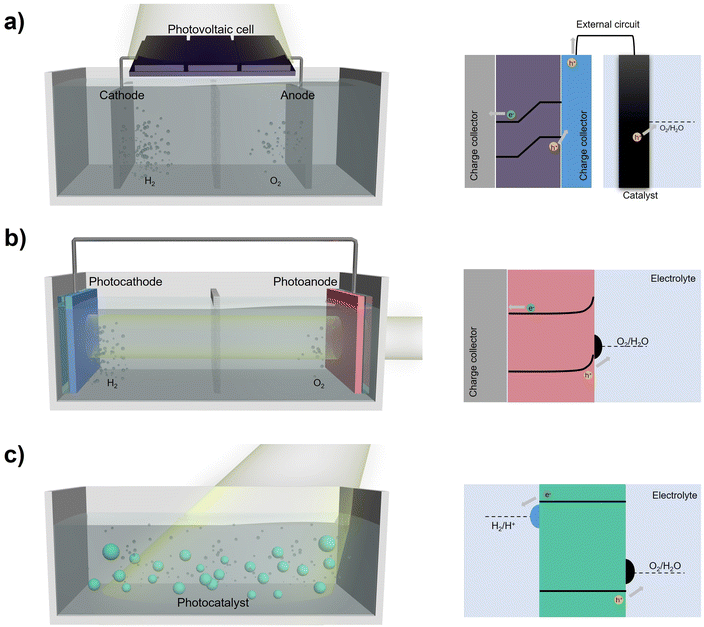 | ||
| Fig. 1 Three different solar water splitting systems and their charge flows upon light absorption. (a) PV-EC, (b) PEC, and (c) PC systems. | ||
In designing efficient PEC devices for unbiased water splitting, three factors should be considered: (1) maximising light absorption, (2) minimising the drift/diffusion length of the electronic charge carrier, and (3) minimising the ion pathway. Meeting all these requirements is highly challenging from different perspectives. For instance, PEC devices must generate a high photocurrent with sufficient photovoltage for the water-splitting reaction. However, the trade-off between maximising the photocurrent and achieving high photovoltage underscores the importance of a tandem design with multiple absorbers, which necessitates efficient light management among light absorbers. In addition, the catalysts require light management as the catalysts for the HER and OER can block light.7 To minimise the parasitic light absorption from catalysts, additional techniques, such as the utilisation of transparent catalysts, ultrathin or patterned catalysts, or spatially decoupled catalysts from the absorber, need to be employed. For charge-carrier transport, the pathways for both electronic (electrons and holes) and ionic charges should be minimised, which is another significant challenge. In this regard, extensive and comprehensive research has been conducted on the design of PEC devices and fundamental considerations for achieving these beneficial conditions for better performance.8,9
To envision an ideal device for unassisted PEC water splitting, first, the device configurations reported in the literature are discussed and classified into three categories: wired tandem PEC devices (Fig. 2a), wireless PEC devices (Fig. 2b), and monolithic PEC devices (Fig. 2c). The wired tandem configuration comprises a photoanode and photocathode, which are connected optically and electrically in series with an external wire. In the wireless configuration, the catalyst is spatially separated from the light absorber but connected by an internal electrical contact. Thus, both parts are connected electrically in series but are optically parallel (Fig. 2b). As this configuration does not involve any external wire, it is called “wireless;” consequently, the pathways for electrons and holes, and thereby the resistance can be reduced. By contrast, in the monolithic configuration, the catalysts and light absorbers are fully integrated, both optically and electrically in series (Fig. 2c). This simple device design allows for a significantly reduced pathway for electrical charge carriers, corresponding to just the thickness of the device. Nevertheless, limited materials and fabrication techniques for the substrate, absorbing layer, and catalysts limit the versatility of this configuration when considering both the electrical and optical aspects of the overall device. In the following section, the advantages and disadvantages of each device configuration are discussed with examples to determine the ideal device configuration for unassisted PEC water splitting.
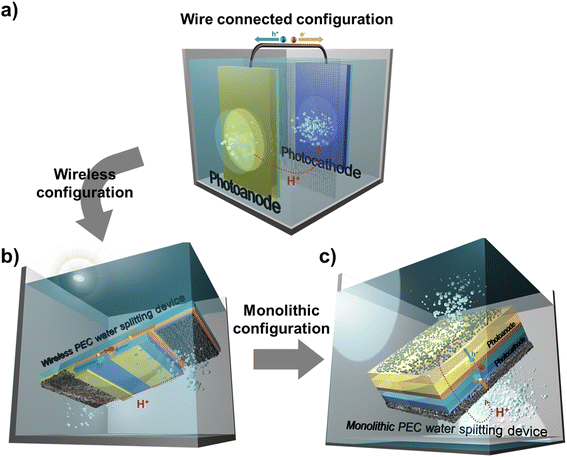 | ||
| Fig. 2 Configurations of unbiased PEC devices. (a) Wire-connected devices, (b) wireless PEC devices, and (c) monolithic PEC devices. | ||
Wire-connected water-splitting PEC devices
A typical wire-connected tandem cell comprises a photoanode and photocathode, with the oxygen evolution reaction (OER) and hydrogen evolution reaction (HER) occurring at the surface of each cell, respectively. To use the solar spectrum effectively, the front electrode absorbs short-wavelength sunlight, while the back photoelectrode captures the long-wavelength sunlight that penetrates the front electrode (Fig. 3a). N-type semiconductors with wide bandgaps are commonly employed as top photoanodes, where the photoexcited holes migrate to the catalyst for the OER. Oxide materials such as BiVO4,10 Fe2O3,11 TiO2,12 and WO3 (ref. 13) have been widely investigated as photoanodes. BiVO4 is one of the most widely studied photoanodes because of its suitable bandgap (2.4 eV), low cost, and good chemical stability. In addition to the photoanodes, narrow-bandgap p-type semiconductors are commonly used as back photocathodes to absorb long-wavelength sunlight. Si,14,15 Cu(In,Ga)Se2 (CIGS),16 Cu2ZnSnS4 (CZTS),17 Cu2O,18 Sb2Se3,19 Cu3BiS3,20 and halide perovskites21 have attracted considerable attention as photocathode materials.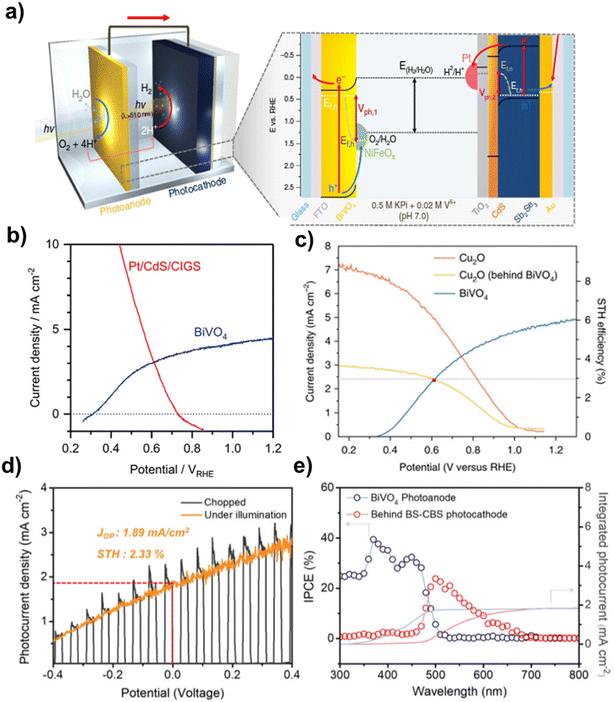 | ||
| Fig. 3 Schematic and performances of the wire-connected configuration. (a) Schematic of the BiVO4-Sb2Se3 wire-connected PEC tandem. Reproduced from ref. 25 with permission from Springer Nature, copyright 2020. Performances of (b) BiVO4-CIGS reproduced from ref. 22 with permission from the Royal Society of Chemistry, copyright 2018, (c) BiVO4-Cu2O, reproduced from ref. 24 with permission from Macmillan Publishers Ltd, part of Springer Nature, copyright 2020, (d and e) BiVO4-Cu3BiS3 wire connected PEC tandem. Reproduced from ref. 20 with permission from Wiley-VCH GmbH, copyright 2023. | ||
BiVO4 has recently emerged as a popular photoanode material for tandem PEC cells owing to its high photocurrent and onset potential. Hence, various photocathodes, such as CIGS, Cu2O, Sb2Se3, and Cu3BiS3, have been coupled with BiVO4 for tandem cells. Domen et al. developed an efficient CIGS photocathode by investigating the effects of the elemental composition of CIGS.22 An unbiased STH efficiency of 3.7% was obtained in combination with a BiVO4 photoanode (Fig. 3b), which holds the record for the best performance among all inorganic material-based wire-connected PEC tandems. The highest STH efficiency among wire-connected PEC tandems was achieved by using the BiVO4 photoanode and organic semiconductor PBDB-T:ITIC:PC71BM (PIP)-based photocathode for which Li et al. demonstrated 4.3% STH efficiency with a BiVO4-PIP system.23 In addition, Grätzel et al. reported a tandem device consisting of a Mo-doped BiVO4 photoanode and Cu2O photocathode, thus achieving an unassisted water-splitting STH conversion efficiency of 3% (Fig. 3c).24 Recently, emerging low-cost p-type semiconductors have also been utilised as photocathodes in wire-connected PEC tandems. Moon et al. developed various novel chalcogenides for photocathodes, such as Sb2Se3 and Cu3BiS3, thus achieving STH efficiencies of 1.5% (ref. 25) and 2.33% (ref. 20) by coupling with a BiVO4-based photoanode, respectively (Fig. 3d and e).
As the photocathodes and photoanodes are fully separated in this wired configuration, both devices can be fabricated and optimised independently; consequently, various combinations can be developed without any fabrication/integration issues. However, novel materials with improved efficiency must be discovered. For instance, even with BiVO4, the best-performing photoanode developed thus far, the theoretical maximum STH efficiency for tandem devices is limited to <10% because of its relatively wide bandgap of 2.4 eV. Therefore, a photoanode material with a narrower bandgap of 1.8–2.0 eV and high performance should be developed to effectively achieve STH efficiency higher than 10%. In addition, the electrical resistance is relatively high because of the external wire; this poses an obstacle for producing cost-effective and efficient large-scale devices.
Wireless PEC water-splitting devices
Currently, wireless PEC devices are fabricated by integrating technologically mature PVs with catalysts for the HER and OER into a single device. Wireless devices reduce device complexity by eliminating external circuits, thereby decreasing costs compared with wire-connected tandem devices.6 In addition, the charge carrier pathway decreases at a higher integration level, thereby reducing the ohmic loss of the overall device. Nevertheless, wireless configurations have not been extensively investigated as they present numerous complexities and difficulties in device fabrication and characterisation. Most reported wireless tandem devices are limited to well-established light absorbers (e.g., III–V semiconductors, amorphous silicon cells, and CIGS). Moreover, the device performance can be characterised only by collecting gaseous products as the configuration does not involve any external wire for measuring the current and potential. This presents a limitation for optimising device performance.Series-connected PVs are commonly employed in wireless PEC devices to generate sufficient photovoltage owing to their high potential for water splitting.26–32 Jacobsson et al. fabricated a three-subcell connected CIGS PV module for a high open circuit voltage of 1.95 V.28 After integrating a Pt catalyst to the PV module, the wireless device generated H2 with 10% STH efficiency (Fig. 4a). Jang et al. proposed a wireless device with a crystalline silicon interdigitated back-contact (c-Si IBC) structure comprising front-side-positioned c-Si and rear-side-positioned OER and HER catalysts (NiOOH and Pt, respectively).26 Notably, the c-Si module and water-splitting catalyst were positioned on the front and rear sides of the wireless device, respectively, to minimise the efficiency loss due to light absorption or reflection from the catalyst (Fig. 4b). Accordingly, the fabricated tandem demonstrated an STH efficiency of 8.4%, which is greater than those of natural leaves (0.1–1%) and C4 plants (4.3–6%).33 The advances in encapsulation and cell design have enabled the use of halide perovskite absorber layers for H2 production with the wireless configuration. As shown in Fig. 4c, a wireless device for solar hydrogen production based on halide perovskite light absorbers could be fabricated with a structure similar to that of PV by spatially separating the catalyst from the absorber and encapsulating the perovskite layer with epoxy to protect it from the electrolyte. Park et al. fabricated a two-subcell halide perovskite-based PV module coupled with Pt and NiFe-OH catalysts for the HER and OER, respectively.27 The chip-type wireless device achieved an unassisted water-splitting STH conversion efficiency of 11%, which is the highest performance for an In-, Ga-free absorber-based wireless PEC tandem. The wireless configuration is feasible for attaining a high photovoltage and performance through techniques such as modularisation by utilising PV materials in the described manner. Additionally, catalysts can be geometrically separated from the light-absorption layer in this configuration, thus eliminating catalyst interference from obstructing light. However, in a large-scale wireless device, the distance between the catalysts and light absorbers (resulting in an increased resistance to electrical conduction), as well as the distance between the OER and HER sites (resulting in an increased resistance to ionic conduction), can be increased. These are disadvantageous for practical applications as they offset the merits of simplicity in small-scale devices.
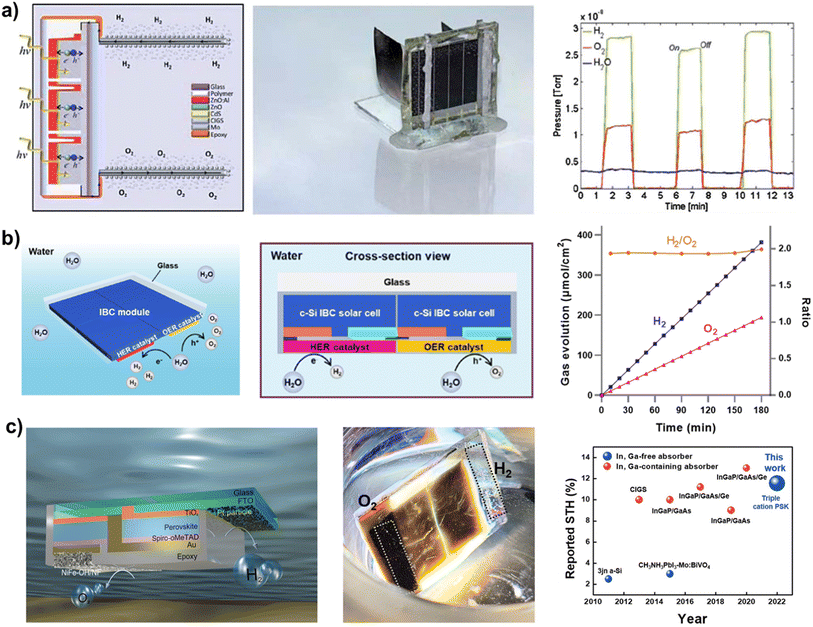 | ||
| Fig. 4 Schematic and performances of (a) the CIGS PV module, reproduced from ref. 28 with permission from the Royal Society of Chemistry, copyright 2013, (b) Si PV module, reproduced from ref. 26 with permission from Elsevier B.V., copyright 2023, and (c) halide perovskite PV module-based wireless PEC configuration. Reproduced from ref. 27 with permission from Wiley-VCH GmbH, copyright 2023. | ||
Monolithic PEC water-splitting devices
The monolithic configuration, also called the “artificial leaf,” exhibits the highest integration level among the bias-free PEC devices. As mentioned above, all the constituents, including the catalysts (both for the OER and HER) and light absorbers, are fully integrated (optically and electrically) in series to ensure that the pathway for the electrical charges can be minimised. Moreover, the monolithic structure allows for a compact design and less electrolyte filling, thereby resulting in smaller space usage.6 Thus, monolithic tandem cells can be employed to achieve practical unbiased PEC water splitting. Monolithic tandem cells were realised by Nocera et al., who employed earth-abundant catalysts on three-junction Si PV.34 The NiMoZn/3jn-a-Si/Co monolithic tandem cell exhibited an STH efficiency of 2.5% (Fig. 5a). An InGaN/Si-based double-junction tandem for unbiased water splitting was further demonstrated, in which a p-type InGaN top junction was directly grown on the bottom of the Si (Fig. 5b).35 Further note that connecting the two different absorbing layers increases the light absorption of the monolithic tandem. After adopting a Pt catalyst, the unbiased water-splitting STH efficiency reached 10.3%. Recently, low-cost metal-oxide-material-based photoanodes have been connected to Si photocathodes to fabricate monolithic tandems. Van de Krol et al. fabricated BiVO4/WO3 metal oxide/n-Si monolithic tandem devices with Fe(Ni)OOH LDH and Pt catalysts.36 They demonstrated the use of low-cost and scalable solution deposition to produce nanostructured tandem photoanodes with n-Si and BiVO4, achieving unassisted water splitting with an STH efficiency of 0.37% with a Pt cathode (Fig. 5c). Although they confirmed the formation of H2 from the unassisted standalone system, the efficiencies were still very low compared with those of III–V-based monolithic devices.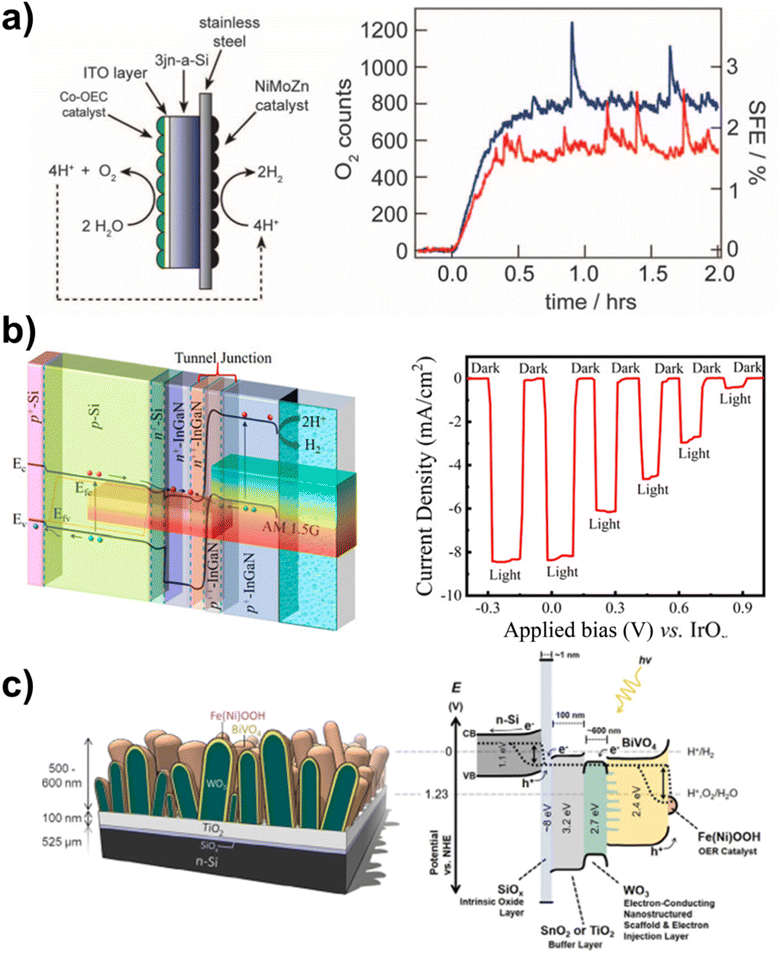 | ||
| Fig. 5 Schematic and performances of (a) series connected Si PV, reproduced from ref. 34 with permission from The American Association for the Advancement of Science, (b) InGaN/Si, reproduced from ref. 35 with permission from the American Chemical Society, copyright 2020, and (c) BiVO4/WO3 metal-oxide/Si-based monolithic PEC devices. Reproduced from ref. 36 with permission from Wiley-VCH GmbH, copyright 2020. | ||
It should be noted that monolithic cells are far from practical because of limited material availability and fabrication technology. The majority of monolithic cells have been fabricated either by the epitaxial growth of III–V semiconductors on single-crystal wafers or by coupling metal oxides with Si.37–40 This approach ensures the charge carrier path without blocking light. However, the practical utilisation of III–V materials is challenging and their efficiency is limited owing to the incompatible annealing conditions for metal oxides and other semiconductors. For metal oxides, process temperature generally exceeds 400 °C, which may damage the photoelectrodes (e.g., a-Si). In addition, catalysts for both the materials and deposition techniques must be carefully selected to prevent light blocking. Moreover, monolithic configurations present an inevitable issue for mass transfer, particularly in large-scale devices. As shown in Fig. 2c, ions are required to travel around from one side of the device to the other side to initiate the counter redox reaction, which significantly increases the resistance to ion transport in a large-scale device. Therefore, despite the potentially minimised electrical current pathway in this monolithic configuration, the pathway for ions should be considered in an idealised device for unbiased solar water splitting.
Table 1 summarizes previous bias-free solar water splitting devices, illustrating clear trends in the development levels for each device configuration. Wire-connected water splitting devices have employed earth-abundant and low-cost materials as light-absorbing layers. However, despite these advancements, overall efficiencies and stabilities remain suboptimal, largely due to the limited choice of photoanode materials, primarily BiVO4. Efficient photoanode development and ensuring overall stability are crucial for advancing wire-connected PEC tandem systems. At higher integration levels, there is a notable improvement in overall efficiencies and stabilities, but this comes at the expense of relying on well-established, high-cost light absorbers. This highlights the need for fabrication methods optimized for integrated devices using earth-abundant materials, alongside the development of additional components such as membranes and transparent electrical contacts. Interestingly, our analysis reveals that despite many OER catalysts being based on low-cost Ni and Fe, most devices still utilize Pt as a HER catalyst. It should be noted that there is a significant reduction in H2 production costs by transitioning from Pt to Ni HER catalysts.41 Hence, the development of low-cost HER catalysts is imperative for reducing H2 production costs and advancing the commercialization of every PEC device configuration.
| Configuration | (Photo)anode material | (Photo)cathode material | Photovoltaic | STH efficiency (%) | Stability | Ref. |
|---|---|---|---|---|---|---|
| Wire-connected water-splitting PEC devices | NiOOH/FeOOH/BiVO4 | Pt/Cu(In,Ga)Se2 | — | 1.01 | 0.5 h | 16 |
| NiFeOx/Mo:BiVO4 | Pt/Cu3BiS3 | — | 2.33 | 21 h | 20 | |
| NiFeOx/BiVO4 | Cu(In,Ga)Se2 | — | 3.7 | 10 min | 22 | |
| Co4O4/BiVO4 | PBDB-T:ITIC:PC71BM | — | 4.3 | 200 min | 23 | |
| NiFeOx/Mo:BiVO4 | NiMo/Cu2O | — | 3 | 12 h | 24 | |
| NiFeOx/Mo:BiVO4 | Pt/Sb2Se3 | — | 1.5 | 10 h | 25 | |
| Wireless PEC water-splitting devices | Ni(OH)2, NiOOH | Pt | c-Si | 8.6 | 3 h | 26 |
| Ni(OH)2 | Pt | FAMACsPbI3 | 11 | 70 min | 27 | |
| Pt | Pt | Cu(In,Ga)Se2 | 10 | 25 h | 28 | |
| RuO2 | Pt | GaAs/InGaP | 8.6 | 2 h | 29 | |
| BiVO4 | Pt | MAPbI3 | 3 | 12 h | 30 | |
| Ni0.9Fe0.1O | Pt | CuInS2 | 3.14 | 2.5 h | 31 | |
| Monolithic PEC water-splitting devices | Co-OEC | NiMoZn | a-Si | 2.5 | 24 h | 34 |
| IrOx | Pt | InGaN/Si | 10.3 | 100 h | 35 | |
| Fe(Ni)OOH/WO3/BiVO4/Si | Pt | — | 0.37 | 2 h | 36 | |
| RuOx | Rh | GaInP/GaInAs/GaAs | 19.3 | 20 h | 37 | |
| NiOOH, Ni(OH)2 | Pt | GaInP/GaAs | 9 | 150 h | 38 | |
| Pt | Pt | Mg:InGaN/Si | 3.4 | 300 h | 39 | |
| IrOx | Pt | TiO2/Si | 0.12 | 4.5 h | 40 |
Outlook
Membrane-embedded PEC water-splitting devices
To overcome the challenges associated with decreasing the ion migration distances, ions must be able to travel through a channel within the device, similar to electrons in monolithic devices. Thus, to develop a practical, ultimate, high-performance device, the concept introduced by Gray in 2009, which involves integrating an ion-conductive membrane into the device, can be utilised.42 As shown in Fig. 6, the bipolar membrane is positioned between the HER and OER counterparts while maintaining electrical connections, thus facilitating both gas separation and ion/electron movement within the device. Nonetheless, creating a membrane-embedded configuration that fulfills all the requirements for effective light absorption and short electron/ion pathways requires further specific prerequisites. As shown in Fig. 6, this configuration has a strong resemblance to a monolithic design; thus, it also faces similar but even more challenging difficulties in terms of fabrication methods and materials for absorbing layers and catalysts owing to the presence of a membrane. Furthermore, the embedded membrane should be optically transparent to minimise optical loss; however, most bipolar membranes developed thus far are not optically transparent. Moreover, to ensure that ions move efficiently within the device without taking circuitous paths, nano/microstructuring of the absorbing layer is necessary, which is another challenge.Owing to these challenging requirements, even more than a decade after its initial proposal, research on bias-free operational membrane-embedded tandem devices is still lacking. In particular, the absence of a transparent and efficient bipolar membrane with an electrical contact, as well as the absence of a permeable yet high-performance tandem device, presents a significant hurdle for an ideal monolithic solar hydrogen device. However, some advances have been made in transparent bipolar membranes,43,44 which can potentially be exploited for the ultimate device structure. A Si-microwire-based device with an embedded membrane, reported by Lewis et al., also demonstrated the potential of this configuration.45 Essentially, they deposited a membrane on two respective Si microwire layers, and the two layers were electrically connected “back to back” through a PEDOT-PSS layer. This fabrication allowed ions to pass through the device, while also enabling the separation of hydrogen and oxygen. However, although the Nafion and QAPSF membranes exhibited very minimal parasite light absorption, PEDOT-PSS still showed approximately 20% absorption, and the device was unable to generate hydrogen without an external bias. Hence, novel materials and manufacturing techniques for membranes and electrical connections that offer appropriate levels of transparency must be explored. Moreover, the development of a tandem device that can generate substantial photovoltage and photocurrent will pave the way for commercialisation of this structure. Finally, a monolithic PEC tandem structure embedded within a membrane can enable the energy-dense storage of solar energy directly as a chemical fuel. Given the similarities in the mechanism, including the light absorption and ion/electron transport, the success of the ideal device design for solar hydrogen production can be expanded toward other types of “artificial leaf,” such as producing chemical fuels from solar energy via CO2 reduction,46 PEC ammonia synthesis,47 and biomass valorisation.48
In summary, to fabricate membrane-embedded PEC water-splitting devices, three key characteristics must be satisfied:
(1) Positioning of the bipolar membrane: the bipolar membrane should be positioned between the HER and OER counterparts, maintaining electrical connections. This arrangement facilitates both gas separation and ion/electron movement within the device.
(2) Optical transparency of the membrane and electrical connection: the membrane and electrical connections must be optically transparent. This transparency is essential for efficient light absorption and transmission, contributing to the overall performance of the device.
(3) Nano/microstructuring of the absorbing layer: nano/microstructuring of the absorbing layer is necessary to enhance its performance by efficient ion movement within the device without taking circuitous paths.
An industrially matured Si has been utilized to create a membrane-embedded structure that operates under an external bias. However, there are limitations associated with using only low-bandgap Si, that is not able to generate the required potential for water splitting. Furthermore, efficiency losses occur due to parasitic light absorption in the electrical connection. Hence, it is imperative to establish a nano/microstructured light-absorbing layer system capable of generating adequate photovoltage. This system should leverage cost-effective materials and processes. Moreover, the creation and integration of transparent electrical connections are pivotal. Lastly, as previously noted, the incorporation of cost-effective and efficient catalysts for the HER and OER, without impeding light transmission, is paramount for the overall success of the membrane-embedded PEC water-splitting device.
Conflicts of interest
The authors declare no competing financial interests.Acknowledgements
This work was supported by the National R&D Program through the National Research Foundation of Korea (NRF) funded by the Ministry of Science and RS-2023-0025177 and grant no. NK242B and NK243H of the Korea Institute of Machinery and Materials.References
- J. H. Kim, D. Hansora, P. Sharma, J. W. Jang and J. S. Lee, Chem. Soc. Rev., 2019, 48, 1908 RSC.
- A. Thakur, D. Ghosh, P. Devi, K. H. Kim and P. Kumar, Chem. Eng. J., 2020, 397, 125415 CrossRef CAS.
- B. A. Pinaud, J. D. Benck, L. C. Seitz, A. J. Forman, Z. B. Chen, T. G. Deutsch, B. D. James, K. N. Baum, G. N. Baum, S. Ardo, H. L. Wang, E. Miller and T. F. Jaramillo, Energy Environ. Sci., 2013, 6, 1983 RSC.
- M. G. Walter, E. L. Warren, J. R. McKone, S. W. Boettcher, Q. X. Mi, E. A. Santori and N. S. Lewis, Chem. Rev., 2011, 111, 5815 CrossRef CAS.
- M. Gratzel, Nature, 2001, 414, 338 CrossRef CAS PubMed.
- C. Moon and B. Shin, Discovery Mater., 2022, 2, 5 CrossRef.
- M. Kumar, B. Meena, P. Subramanyam, D. Suryakala and C. Subrahmanyam, NPG Asia Mater., 2022, 14, 88 CrossRef CAS.
- B. Liu, S. J. Wang, G. Zhang, Z. C. Gong, B. Wu, T. Wang and J. L. Gong, Chem. Soc. Rev., 2023, 52, 4644 RSC.
- W. Yang, R. R. Prabhakar, J. Tan, S. D. Tilley and J. Moon, Chem. Soc. Rev., 2019, 48, 4979 RSC.
- H. S. Han, S. Shin, D. H. Kim, I. J. Park, J. S. Kim, P. S. Huang, J. K. Lee, I. S. Cho and X. L. Zheng, Energy Environ. Sci., 2018, 11, 1299 RSC.
- C. C. Li, A. Li, Z. B. Luo, J. J. Zhang, X. X. Chang, Z. Q. Huang, T. Wang and J. L. Gong, Angew. Chem., Int. Ed., 2017, 56, 4150 CrossRef CAS PubMed.
- Q. H. Yi, S. Cong, H. Wang, X. J. Zhou, J. M. Chen, K. Li, Y. S. Liu and J. M. Lee, ACS Appl. Energy Mater., 2021, 4, 14440 CrossRef CAS.
- J. J. Zhang, X. X. Chang, C. C. Li, A. Li, S. S. Liu, T. Wang and J. L. Gong, J. Mater. Chem. A, 2018, 6, 3350 RSC.
- H. P. Wang, K. Sun, S. Y. Noh, A. Kargar, M. L. Tsai, M. Y. Huang, D. L. Wang and J. H. He, Nano Lett., 2015, 15, 2817 CrossRef CAS PubMed.
- B. Seger, T. Pedersen, A. B. Laursen, P. C. K. Vesborg, O. Hansen and I. Chorkendorff, J. Am. Chem. Soc., 2013, 135, 1057 CrossRef CAS PubMed.
- M. X. Chen, Y. Liu, C. C. Li, A. Li, X. X. Chang, W. Liu, Y. Sun, T. Wang and J. L. Gong, Energy Environ. Sci., 2018, 11, 2025 RSC.
- X. L. Yu, A. Shavel, X. Q. An, Z. S. Luo, M. Ibáñez and A. Cabot, J. Am. Chem. Soc., 2014, 136, 9236 CrossRef CAS PubMed.
- A. Paracchino, V. Laporte, K. Sivula, M. Grätzel and E. Thimsen, Nat. Mater., 2011, 10, 456 CrossRef CAS PubMed.
- J. Park, W. Yang, J. Tan, H. Lee, J. W. Yun, S. G. Shim, Y. S. Park and J. Moon, ACS Energy Lett., 2020, 5, 136 CrossRef CAS.
- S. Moon, J. Park, H. Lee, J. W. Yang, J. Yun, Y. S. Park, J. Lee, H. Im, H. W. Jang and W. Yang, Adv. Sci., 2023, 10, 2206286 CrossRef CAS PubMed.
- M. Crespo-Quesada, L. M. Pazos-Outon, J. Warnan, M. F. Kuehnel, R. H. Friend and E. Reisner, Nat. Commun., 2016, 7, 12555 CrossRef CAS PubMed.
- H. Kobayashi, N. Sato, M. Orita, Y. Kuang, H. Kaneko, T. Minegishi, T. Yamada and K. Domen, Energy Environ. Sci., 2018, 11, 3003 RSC.
- S. Ye, W. Shi, Y. Liu, D. Li, H. Yin, H. Chi, Y. Luo, N. Ta, Fe. Fan, X. Wang and C. Li, J. Am. Chem. Soc., 2021, 143, 12499 CrossRef CAS PubMed.
- L. F. Pan, J. H. Kim, M. T. Mayer, M. K. Son, A. Ummadisingu, J. S. Lee, A. Hagfeldt, J. S. Luo and M. Grätzel, Nat. Catal., 2018, 1, 412 CrossRef CAS.
- W. Yang, J. H. Kim, O. S. Hutter, L. J. Phillips, J. Tan, J. Park, H. Lee, J. D. Major, J. S. Lee and J. Moon, Nat. Commun., 2020, 11, 861 CrossRef CAS PubMed.
- W. J. Jin, C. Shin, S. Lim, K. M. Lee, J. M. Yu, K. Seo and J. W. Jang, Appl. Catal., B, 2023, 322, 122086 CrossRef CAS.
- J. Park, J. Lee, H. Lee, H. Im, S. Moon, C. S. Jeong, W. Yang and J. Moon, Small, 2023, 19, 2300174 CrossRef CAS PubMed.
- T. J. Jacobsson, V. Fjallstrom, M. Sahlberg, M. Edoff and T. Edvinsson, Energy Environ. Sci., 2013, 6, 3676 RSC.
- E. Verlage, S. Hu, R. Liu, R. J. R. Jones, K. Sun, C. X. Xiang, N. S. Lewis and H. A. Atwater, Energy Environ. Sci., 2015, 8, 3166 RSC.
- J. H. Kim, Y. Jo, J. H. Kim, J. W. Jang, H. J. Kang, Y. H. Lee, D. S. Kim, Y. Jun and J. S. Lee, ACS Nano, 2015, 9, 11820 CrossRef CAS PubMed.
- S. Esiner, R. E. M. Willems, A. Furlan, W. W. Li, M. M. Wienk and R. A. J. Janssen, J. Mater. Chem. A, 2015, 3, 23936 RSC.
- S. Kim, T. Kim, S. Lee, S. Baek, T. Park and K. Yong, Adv. Mater., 2017, 29, 1702431 CrossRef PubMed.
- D. A. Walker, J. Appl. Phycol., 2009, 21, 509 CrossRef.
- S. Y. Reece, J. A. Hamel, K. Sung, T. D. Jarvi, A. J. Esswein, J. J. H. Pijpers and D. G. Nocera, Science, 2011, 334, 645 CrossRef CAS PubMed.
- S. Vanka, B. W. Zhou, R. A. Awni, Z. N. Song, F. A. Chowdhury, X. D. Liu, H. Hajibabaei, W. Shi, Y. X. Xiao, I. A. Navid, A. Pandey, R. Chen, G. A. Botton, T. W. Hamann, D. W. Wang, Y. F. Yan and Z. T. Mi, ACS Energy Lett., 2020, 5, 3741 CrossRef CAS.
- I. Y. Ahmet, S. Berglund, A. Chemseddine, P. Bogdanoff, R. F. Präg, F. F. Abdi and R. van de Krol, Adv. Energy Sustainability Res., 2020, 1, 2000037 CrossRef.
- W. H. Cheng, M. H. Richter, M. M. May, J. Ohlmann, D. Lackner, F. Dimroth, T. Hannappel, H. A. Atwater and H. J. Lewerenz, ACS Energy Lett., 2018, 3, 1795 CrossRef CAS.
- P. Varadhan, H.-C. Fu, Y.-C. Kao, R.-H. Horng and J.-H. He, Nat. Commun., 2019, 10, 5282 CrossRef PubMed.
- Y. J. Wang, Y. P. Wu, J. Schwartz, S. H. Sung, R. Hovden and Z. T. Mi, Joule, 2019, 3, 2444 CrossRef CAS.
- C. Liu, J. Y. Tang, H. M. Chen, B. Liu and P. D. Yang, Nano Lett., 2013, 13, 2989 CrossRef CAS PubMed.
- C. A. Rodriguez, M. A. Modestino, D. Psaltis and C. Moser, Energy Environ. Sci., 2014, 7, 3828 RSC.
- H. B. Gray, Nat. Chem., 2009, 1, 7 CrossRef CAS PubMed.
- S. Chabi, A. G. Wright, S. Holdcroft and M. S. Freund, ACS Appl. Mater. Interfaces, 2017, 9, 26749 CrossRef CAS PubMed.
- Y. Jeon, V. D. C. Tinh, V. D. Thuc and D. Kim, Chem. Eng. J., 2023, 459, 141467 CrossRef CAS.
- J. M. Spurgeon, M. G. Walter, J. F. Zhou, P. A. Kohl and N. S. Lewis, Energy Environ. Sci., 2011, 4, 1772 RSC.
- P. Ding, T. Jiang, N. Han and Y. Li, Mater. Today Nano, 2020, 10, 100077 CrossRef.
- S. Zhou, K. Sun, C. Y. Toe, J. Yin, J. Huang, Y. Zeng, D. Zhang, W. Chen, O. F. Mohammed, X. Hao and R. Amal, Adv. Mater., 2022, 34, 2201670 CrossRef CAS PubMed.
- S. Kim, H. C. Kang, C. Chu, S. Y. Li, K. Yoo, U. K. Wijethunga, W. W. Zheng, C. G. Yoo, B. D. Sherman, J. J. Lee and G. Leem, Sustainable Energy Fuels, 2023, 7, 2339 RSC.
| This journal is © The Royal Society of Chemistry 2024 |

